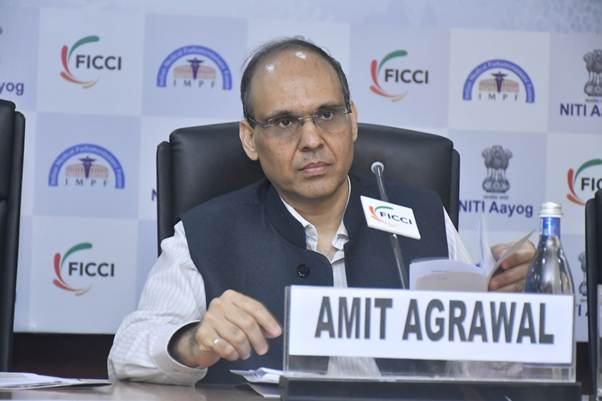India has pledged to make treatments for rare diseases more affordable, using a mix of policy incentives and budget support, as government and industry leaders gathered in New Delhi this week to debate how to tackle one of the most neglected corners of healthcare.
At the Rare Diseases Conference 2025, held at the Federation of Indian Chambers of Commerce and Industry (FICCI) auditorium, Department of Pharmaceuticals Secretary Amit Agrawal said the government’s Production Linked Incentive (PLI) scheme was already driving down the cost of therapies once priced beyond the reach of most families.
Agrawal told delegates that under the PLI scheme, eight drugs for rare conditions have been supported, including Eliglustat for Gaucher’s disease. The cost of treatment, once ranging between ₹1.8 crore and ₹3.6 crore ($207,000–$414,000) annually, has been slashed to just ₹3–6 lakh ($3,450–$6,900). Similar reductions have been achieved for Trientine for Wilson’s disease, Nitisinone for Tyrosinemia Type 1 and Cannabidiol for Lennox–Gastaut Syndrome.
“Rare diseases may appear infrequent individually, but together they affect one in every twenty people,” Agrawal said. “This is not just a medical issue but a question of inclusion.”
The conference, themed “Making Rare Care Possible: Availability, Accessibility, Awareness,” brought together policymakers, researchers, drugmakers and patient advocates. Sessions focused on lowering treatment costs, creating inclusive regulatory pathways, and scaling up patient support programs.
From vision to policy
Agrawal cited Prime Minister Narendra Modi’s Independence Day address this month, in which he urged the country’s pharmaceutical sector to move beyond generics and invest in innovation. “We are known as the pharmacy of the world, but isn’t it the need of the hour to invest in research and development? Shouldn’t we be the ones providing the best and most affordable medicines for the welfare of humanity?” Modi asked in his speech.
The secretary encouraged pharmaceutical firms to expand corporate social responsibility (CSR) and patient assistance schemes to cover rare diseases, given the immense financial burden on families. He also suggested that India consider special regulatory pathways, including exemptions or accelerated approvals, to address the unique needs of patients with rare conditions.
Fiscal support rising
The government has paired policy intent with funding. The Department of Pharmaceuticals saw its allocation rise nearly 29 percent in the 2025–26 Union Budget to ₹5,269 crore ($606 million). The PLI scheme alone accounted for ₹2,445 crore ($281 million), while ₹1,460 crore ($168 million) was earmarked for bulk drug parks.
The rare disease fund, once seen as symbolic, has steadily expanded. Annual support grew from ₹35 crore ($4 million) in 2022–23 to ₹74 crore ($9 million) in 2023–24, and to ₹82.4 crore ($9.5 million) this fiscal year, with more than ₹34 crore ($3.9 million) already disbursed. Separately, the Finance Ministry has exempted customs duty on 36 life-saving drugs, including those for rare conditions, and cut the duty on six others to 5 percent.
The broader health ministry budget climbed to ₹90,959 crore ($10.46 billion), up from ₹80,518 crore a year earlier, reflecting a 12 percent increase.
Patients still waiting
Despite policy advances, gaps remain. India’s first rare disease policy in 2021 capped government support at ₹50 lakh ($57,500) per patient, a fraction of the real cost. A Delhi High Court order last year directed the creation of a ₹974 crore ($112 million) national rare disease fund over two years, but implementation remains stalled in the Supreme Court.
Advocacy groups say more than 300 patients with lysosomal storage disorders are still awaiting treatment, and nearly 50 have died since 2022. Centers of Excellence tasked with delivering therapies continue to flag bureaucratic delays and technical limitations.
Global contrasts
Globally, the orphan drug market is projected to hit $300 billion by 2030, driven by strong incentives in the United States and Europe. But those incentives have encouraged premium pricing, with annual therapy costs often topping $150,000. Even in rich countries, patient access is limited.
India is attempting to break that model by anchoring incentives in domestic production while using its pricing authority to keep drugs affordable. Industry watchers say the approach could make India a rare example of a country offering orphan therapies at scale without the financial strain seen in advanced economies.
“India could provide a new template,” said one senior pharma executive. “The real test will be execution—ensuring safety, quality and timely access without diluting affordability.”
Industry interest and caution
Some Indian companies have moved into the space. Dr. Reddy’s Laboratories has partnered with Belgium’s UCB to distribute an epilepsy drug at reduced cost. Sun Pharma and Biocon have invested in biologics platforms with potential rare disease applications.
But multinationals have been wary. With strict price controls and relatively small patient volumes, India remains a marginal market for most global orphan drugmakers. Analysts say stronger fiscal incentives and regulatory clarity will be required to attract deeper investment.
The Rare Diseases Conference 2025 highlighted both the urgency and complexity of India’s challenge: tens of millions affected by rare conditions, treatments historically priced out of reach, and a fragile policy environment still finding its feet.
If successful, India could not only improve access for its own patients but also emerge as a global supplier of affordable orphan drugs. But failure to implement funding pledges and regulatory reforms risks leaving patients stranded, even as headline allocations rise.
As Agrawal closed his address, he struck a note of empathy: “This is not only about science and industry. It is about whether we can look at the rare disease community with compassion, and design systems that do not leave them behind.”
($1 = ₹86.97)






